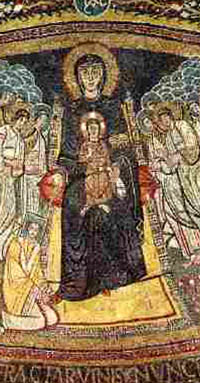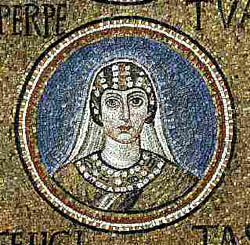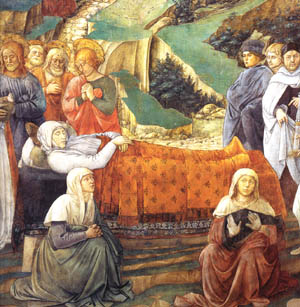 |
Catholic Customs
A Study of the Veil in the Christian Tradition - Part 1
The Veil in the Apostolic Age
Donald P. Goodman III
The veil certainly had a part in the Christian tradition as preached by the Apostles. It was, of course, not of paramount importance; in a time of persecution, the good Bishop encourages his flock in the maintenance of the Faith and the practice of good, and his focus on externals must necessarily decrease as he attempts to prepare his people for martyrdom. However, even in these circumstances, the Apostles, our first Bishops and the holiest of men since the dormition of Our Blessed Mother, found time to preach the practice of the veil, though briefly and without much specification.

Our Lady appears with a head covering in an Early Christian mosaic in Ravenna |
I first, of course, investigate the Scriptures, which are, as always, the most authoritative source to which any Catholic can appeal. The Scriptures, while written through the medium of human hands, are authored primarily by the Holy Ghost, and consequently quite literally have a divine authority. What I find here, therefore, will be formative to the entire discussion, from the Church Fathers to our own time. The entire Christian veil tradition finds its roots in Holy Writ, and derives its authority and its raison d’etre from it. In fact, the only infallible source of doctrine on the veil in recorded history is in the Scriptures; my discussion shall be focused on that.
Any Catholic at all familiar with the Scriptures has run across I Corinthians 11, the chapter in which St. Paul discusses hair, veils, and hats. This chapter gives us a number of clues about the Christian tradition of the veil and the head-covering in general from a number of different avenues. First I will quote the text in its entirety, both to refresh the reader’s memory and to put the focus of the discussion on the table as explicitly as possible. Then I will begin an exegesis of the relevant Writ in the light of the apostolic age.
2.1 The veil text
The Scriptural text, which I shall refer to as “the Veil Text,” upon which the whole Christian theology of the veil is based, is surprisingly lengthy considering the treatment which other subjects receive in its context. It reads:
“Be ye followers of me, as I also am of Christ. Now I praise you, brethren, that in all things you are mindful of me: and keep my ordinances as I have delivered them to you. But I would have you know, that the head of every man is Christ; and the head of the woman is the man; and the head of Christ is God. Every man praying or prophesying with his head covered, disgraceth his head. But every woman praying or prophesying with her head not covered, disgraceth her head: for it is all one as if she were shaven. For if a woman be not covered, let her be shorn. But if it be a shame to a woman to be shorn or made bald, let her cover her head. The man indeed ought not to cover his head, because he is the image and glory of God; but the woman is the glory of man. For the man is not of the woman, but the woman of the man. For the man was not created for the woman, but the woman for the man.
"Therefore ought the woman to have a power over her head, because of the angels. But yet neither is the man without the woman, nor the woman without the man, in the Lord. For as the woman is of the man, so also is the man by the woman: but all things of God.
You yourselves judge: doth it become a woman, to pray unto God uncovered? Doth not even nature itself teach you, that a man indeed, if he nourish his hair, it is a shame unto him? But if a woman nourish her hair, it is a glory to her; for her hair is given to her for a covering. But if any man seem to be contentious, we have no such custom, nor the church of God.” (1)
2.2 A simple exegesis
What follows is a very simple exegesis of the text, simple because the more complex exegesis is the subject of this entire article. For now I wish simply to lay out a surface interpretation of the text, an interpretation which merely takes St. Paul’s words and gives them their facial meaning. Essentially, St. Paul is saying that the veil — from the Latin velare, to cover — is necessitated by the tripartite relationship of God, man, and woman.
This facial reading is entirely clear. St. Paul begins by explaining that “the head of every man is Christ; and the head of the woman is the man; and the head of Christ is God.” Here he is drawing an analogy, a classic analogy that has been used throughout the History of the Church, particularly in explaining the Sacrament of Matrimony: that man is to woman as Christ is to the Church. The head of man, St. Paul tells us, is Christ; the head of woman is man. He further tells us that man “is the image and glory of God; but the woman is the glory of man.” Also, he observes that “the man is not of the woman, but the woman of the man.” The analogy of God and man to man and woman is clear, and definitely not alien to St. Paul.
Indeed, St. Paul is most hated by modern feminists because of his formulation of this very theory in his Epistle to the Ephesians. There St. Paul makes the analogy much more explicitly, but it can easily be recognized as the same analogy all the same:
“Let women be subject to their husbands, as to the Lord: Because the husband is the head of the wife, as Christ is the head of the church, He is the saviour of his body. Therefore as the church is subject to Christ, so also let the wives be to their husbands in all things. Husbands, love your wives, as Christ also loved the church, and delivered himself up for it.”
The similarities between the passages are clear: the Veil Text and this text from Ephesians are expressing the same analogy. Indeed, the Douay-Rheims even makes a cross-reference to Ephesians 5 in I Corinthians 11, and vice versa. So, incidentally, do some newer translations, including the Catholic Edition of the Revised Standard Version — although that version neglects a cross-reference from Ephesians back to I Corinthians, it recognizes the tie between the two by referencing Ephesians from I Corinthians. The conclusion that St. Paul is drawing the same analogy in both passages is inescapable.
Table 1: Man and woman in divine analogies
| Man | Woman |
| God | Christ |
| Christ | The Church |
| Christ |
Man |
| Image of God |
Image of Man |
| Contemplation | Practical Reason |
St. Paul then uses this analogy to justify his requirement that women cover their heads. After reminding us that “the man was not created for the woman, but the woman for the man,” he tells us that “[t]herefore ought the woman to have a power over her head, because of the angels.” One can only conclude that this “power” of which he speaks is the covering, the veil, mentioned earlier; he argues that, because man is to woman as Christ is to mankind, a woman ought to be veiled. That is the unavoidable reading of the text, if it is read with regard only for itself.
St. Jerome translates this passage as “ideo debet mulier potestatem habere supra caput” [needs translation; please change it if it is necessary – “therefore the woman must wear the (symbol of the man’s) power over her head”]; we see that St. Jerome gave it a literal translation, and consequently did not further reveal its meaning. The Greek,according to Liddell and Scott, translates to “power” or “authority.”

St. Perpetua - Early Christian mosaic |
This power, however, is not simply a strange way of saying “covering”; it means, quite literally, power or authority. The woman does not need a covering on her head in this verse; she needs authority over her head, “supra caput.” St. Paul is talking about authority being over the woman, just as God is in authority over mankind. The woman, therefore, needs “authority” over her head; the veil, the covering, represents that authority. St. Paul is setting up the veil as a sign of woman’s subjection to man.
The fruit of this doctrine of submission and covering is that simply by appearing with a covering on her head, the woman is giving testimony to many of Catholicism’s greatest truths. She proclaims simply by her head being covered that God is greater than man; that man is the leader within mankind; that woman is subjected to man. She is also proclaiming her personal submission to Jesus Christ, to her husband if she is married, and to her superiors if she is not. A mere garment declares all these things to a doubting world; woman is quite privileged to be able to wear it.
This analogy of Christ and mankind to man and woman also extends to the relationship of God to the Church. That is, man is to woman as Christ is to the Church. St. Paul himself makes this extension, telling us that “the husband is the head of the wife, as Christ is the head of the church.” So a woman who appears with a covered head is also proclaiming the submission of the Church to Christ, the covering on her head symbolizing the Church’s universal submission. Furthermore, by proclaiming one end of the analogy, she is also proclaiming the other. The covered woman is giving witness to the fact that “Christ also loved the Church, and delivered himself up for it.” She declares that her husband must love her just as Christ loves His Church, and that God lovingly watches over mankind just as — and much better than — her husband lovingly watches over her. This simple garment, when understood in this way, is a powerful witness to the Catholic faith; happy the sex that with so simple a gesture can proclaim such noble truths!
St. Paul illustrates this truth by referencing customs concerning hair. He argues that men having short hair is the same as them keeping their heads uncovered; it symbolizes their authority over woman and the authority of Christ over the Church. Similarly, women having long hair is the same as them keeping their heads covered; it symbolizes their submission to man, and the submission of the Church to Christ. While this may seem like a local custom, St. Paul seems to hold otherwise, asking the Corinthians whether “nature itself” teaches “that a man indeed, if he nourish his hair, it is a shame unto him? But if a woman nourish her hair, it is a glory to her; for her hair is given to her for a covering.” The custom of the veil, then, is reflected in nature; women grow their hair long because it is natural for their external appearance to reflect their submission, and men keep theirs short because it is natural for their external appearance to reflect their authority. The veil is how we perfect nature’s symbolism.

In the Dormition of the Virgin Mary, Our Lady and the grieving women are pictured with the traditional head coverings |
But does not St. Paul say that “her hair is given to her for a covering?” Why, then, does she need to wear a veil, when she is already covered? For the same reason that we wear wedding rings even though the Sacrament endures without them. Men require artificial signs of natural realities. One might as well ask why the priest wears vestments, when the very fact of offering the Mass is a sign of his authority. St. Paul requires women to cover their heads in addition to their long hair while “praying and prophesying,” saying that to do otherwise is like being shaven.
If he were referring only to the woman’s long hair, then to pray and prophesy uncovered would actually be praying and prophesying shaven, and the analogy of uncovered to shaven would be superfluous. So St. Paul was definitely speaking of an actual covering over the woman’s head over and above her natural covering, at least while praying and prophesying. At other times, it seems, the hair alone is sufficient symbol of her submission to her husband.
This, at least, is what seems to me to be the only coherent interpretation of the text before hearing the words of the Church on the subject. What has the Church taught concerning these passages? The Church has not taught anything infallibly regarding their interpretation. However, many great thinkers have approached these verses, including Fathers and Doctors of the Church. I will examine their opinions of their meaning, and only then form a final opinion of my own.
1. Corinthians 11:1–16. Taken from the Douay-Rheims, Challoner edition (Rockford, IL: TAN Books and Publishers, Inc., 1971). Unless otherwise noted, all further English scriptural quotations will be from this source.
2. Corinthians 11:3.
3. Corinthians 11:7.
4. Corinthians 11:8.
5. Ephesians 5:22–25.
6. Corinthians 11:9–10.
7. Corinthians 11:10. Biblia Sacra iuxta Vulgatam Versionem. Germany: Deutsche Bibelgesellschaft, 1994. Unless otherwise noted, all further Latin Scriptural quotations will be from this source.
8. Ephesians 5:23.
9. Ephesians 5:25.
10. Corinthians 11:14–15.
11. Corinthians 11:5.

Posted April 8, 2005
Go to Introduction Part 2 Part 3 Part 4 Part 5 Part 6 Conclusion
The pleasure TIA has to publish collaborations of our guest columnists does not imply that it endorses all the opinions expressed in their articles.
Return to TOP

Related Topics of Interest
 Restoration: Let's Begin with the Veil Restoration: Let's Begin with the Veil
 St. Pius X on Priestly Dignity and Propriety St. Pius X on Priestly Dignity and Propriety
 Titles and Signs of Respect for Priests and Religious Titles and Signs of Respect for Priests and Religious

Related Works of Interest
|
Catholic Customs | Religious | Home | Books | CDs | Search | Contact Us |
Donate

© 2002- Tradition in Action, Inc. All Rights Reserved
|
 |
|